
Figure 1. Zabarwan Mountain chain and Dal Lake, Srinagar, Kashmir.(GMap at zoom 15 – Google TerrainMap-634958246884375000.png)
Twenty water samples (five each) of four springs of Zabarwan Mountains, Srinagar, Kashmir were analyzed on Atomic Absorption Spectrophotometer for various cations. The heavy metal elements concentration Ni, Cu, Fe, Pb and Mn were found above permissible limits; Ni, Pb, Mn and Fe being higher in Zeethyar and Cheshma Shahi Springs, Ni, Cu, Fe, Mn and Pb in Ishber and Fe in Durganag Spring. The comparison of average of these with the average of the samples from Dal-Lake waters indicates that the load of heavy metal concentration has been contributed by these springs. Among anions nitrate level of the springs is slightly on the higher side, though not alarming at present it may cause a health hazard in the whole region. Hardness and Ph values of all the samples are within the permissible ranges. The turbidity values of Ishber and Durganag springs are above permissible limits. The S.A.R. values (<26) and the S.S.P values (<60) indicate that the water of these springs can safely be used for agricultural purposes.
The valley of Kashmir, girdled by Greater Himalaya in the east and northeast and by Pir Pinjal mountains in the south and southwest is about 140 Kms long and 33 to 41 Kms wide. From these main mountain chains issue out various ranges and ridges into the low lying valley. At some places, the ridges are completely dismembered by erosion from the present mass, but on the whole, ranges slope towards the valley.
Zabarwan mountain is one of the chains issuing out from main Pir Panjal Range and constitutes a conspicuous relief feature to the east, the maximum elevation of which is 2,727 m above mean sea level (Figure 1). These mountains are in a curvilinear plan and numerous spurs and ridges branch out from it. These ridges hold some of the important peaks, viz Barobal (2597m), Badyor (2121m). The reputed Bren spur (locally called Krala Sangar) lies to the west at the base of these mountains. This spur stands about 1696 m above mean sea level and is separated from the adjoining mountain mass by a saddle. In the North and East, the mountain mass is limited by a water course that issues out from a city water reservoir. In the south it is continued in the form of similar ridges and spurs. In the background of Zabarwan Mountains the snow-clad peak Mahadev (4030m) above mean sea level is visible. Beyond Harwan in the north extend the Kangan mountain which holds the Sind valley. There are other two separate hills one Hariparbat (1729m) and Shankaracharya (1893m) situated to northwest and southeast of Zabarwan Mountains respectively. The Shankaracharya Hill is the south extension of Zabarwan peak which in the geological past got separated by erosion from the main mass and is presently in the form of a saddle. Springs and oozing of water at the foot hills of Zabarwan mountain is a common observation in the valley. A few of these springs have been selected for the present study. The springs from south to north are Zeethyar, Cheshma Shahi and Ishber. All these springs can be approached from Boulevard road. Every year visitors visit these places during the summer months. Zeethyar and Ishbar are the springs visited by local people on festive occasions. Cheshma Shahi is about 1.5Km uphill from the Boulevard road and is about 10Kms from Srinagar City centre. Oozing of water is observed at a height of 1694m at a number of places. The spring has been covered by a stone structure and its water shed area constitutes a trap rock. It has a beautiful garden in front and there exist number of fountains.

Figure 1. Zabarwan Mountain chain and Dal Lake, Srinagar, Kashmir.(GMap at zoom 15 – Google TerrainMap-634958246884375000.png)
Ishber is at a distance of about 6Kms from Cheshma Shahi and falls geographically in Nishat area. At the base of Shankaracharya Hill a comparatively small spring, the waters of which issue out from Panjal trap and over which the present structure of Durga Nag temple has been constructed. Though the main outlet is concealed, it is presumed it has resulted merely due to intercommunitive fissures and fractures in the trap. The reservoir which is fed by the main spring where oozing takes place falls on the right side facing towards Shankaracharya Hilll past below the main temple Durga Nag. The dimensions of the reservoir at Durganag are 5.35 m x 4.62 m x 1.64 m. All the four springs are affected by the trap rocks and under lying Agglomeratic Slates. The traps of Zabarwan mountain are continuous across Arrah Nalla with those of Sind valley, Manasbal and along the north eastern shores of the Wular Lake.
Water shed areas of the springs of the present study are mainly the trap rocks. There exists adequate forest cover in the northern slopes of Zabarwan mountain, but in the south and southeastern parts, the slopes are barren and so there is fast erosion bringing out disintegrated matrix from trap rocks and the Agglomeratic Slates thus affecting the chemistry of the waters of the springs. The runoff from the springs finally pours into the famous Dal Lake of Srinagar which is already polluted heavily (Fotedar and Raina,1993).
During the last a few years, most of the upper parts of Zavbarwan mountain have started becoming crowded due to rapid urbanization. The people live there with bad sanitation and many of septic tanks and cess pools have come up which directly pour contaminants into the springs, excepting Durga Nag spring, where no population occurs in the water shed area. The condition of Dal Lake is deteriorating day by day, since run offs from all the four springs pour into Dal waters. The detailed study of the springs, therefore, has been attempted at in this paper.
Twenty water samples from the four springs (five samples from each spring) were collected in April, 2012. These were stored in polythene bottles which were washed with double distilled water. Major and trace elements were determined on Atomic Absorption Spectrophotometer (GBC Model-902, Australian Make). The anions were determined on 550 Perkin Elmer UV Spectrophotometer. All the A.R.Chemicals used were obtained from BDH. (Bombay) and CDH (Delhi).
The springs Zeethyar, Cheshma Shahi, Ishber and Durga Nag bring out a great amount of run off that pours finally into Dal Lake waters. (Loan, F .M., 1973). The over all effects of urbanization, bad sanitation, excessive manuring in the whole belt of Zabarwan Range, differs to a great extent and this has resulted in bringing out intrinsic differences in the concentration of heavy metals in the springs in question. The physico-chemical data of the four springs has been presented in the Table 1(a)- Table 1(d).
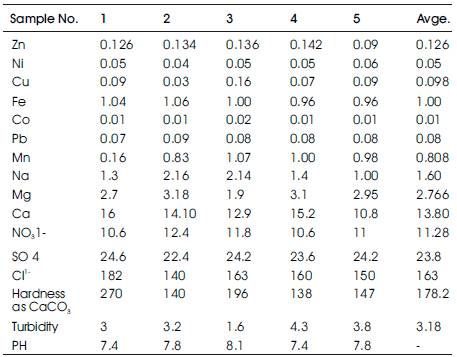
Table 1(a). Chemical Data of Springs of Zabarwan Mountains, Srinagar- Kashmir -ZEETHYAR SPRING
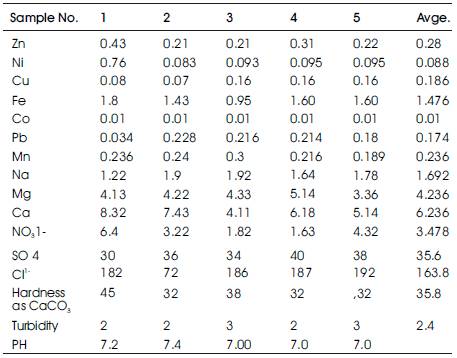
Table 1(b). Chemical Data of Springs of Zabarwan Mountains, Srinagar- Kashmir -CHESHMASHAHI SPRING
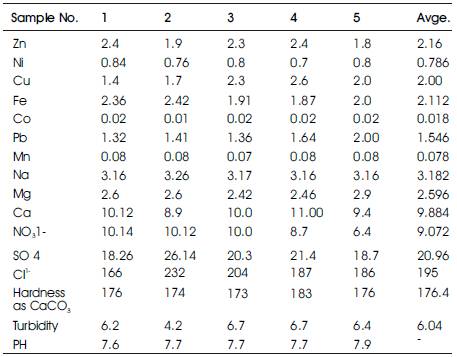
Table 1(c). Chemical Data of Springs of Zabarwan Mountains, Srinagar- Kashmir -ISHBER SPRING
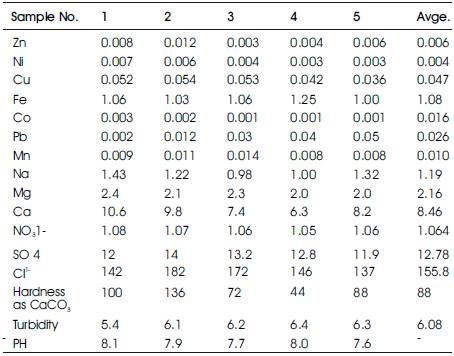
Table 1(d). Chemical Data of Springs of Zabarwan Mountains, Srinagar- Kashmir -DURGA NAG SPRING
Zinc: The Zn concentration out of all the four springs, is maximum in case of Ishber spring (0.43 ppm on an average basis). Zinc concentration involves the sulphide phase which occurs more in phyllites of the Agglomeratic Slates as compared to traps. There is only a very thin exposure of Agglomeratic Slates present in the Shankaracharya hill, rather it is ill represented and as such this may account of less concentration of Zn present in the waters of Durga Nag spring. On the other hand a big area in the watershed of Ishber spring has been all occupied-by rapid urbanization mostly unauthorized during the last two decades after removing the forest cover, resulting in fast erosion of the rocks facilitating more of particulate matter from the higher levels which clearly accounts for more concentration of this heavy metal in the waters of Ishber spring. The maximum erosion is caused by Arrah Nalla in the north along with Harwan Nalla which occur at a close range of Ishber spring compared to other three springs. In the present case, the difference in the rate of erosion in four different places in the Zabarwan is directly proportional to the contributions of zinc in the solutions of the waters of the springs. However, the overall Zinc concentration of the 20 samples of the four springs comes to 0.642 ppm, lower than the permissible limit (W.H.O.1984 and BIS, 1991) and hence waters can be considered harmless for human consumption. Lickens (1985) has done a classic work on Mirror Lake, Hampshire. He reports that at least with adequate forest cover the heavy metals can be screened off to a reasonable amount to enter into the water systems.
Similarly, forestation in the eastern and southeastern slopes of Zabarwan can check to a great extent the entry of heavy metals into the solution of water.
Nickel: - Nickel concentration has been found highest in Ishber spring among all the samples analyzed (i.e. average 0.786 ppm). In Cheshmashahi and Zeethyar springs, though the concentration of Ni is lower to that found in Ishber spring, yet it is above the permissible limits. Nickel is a chalcophile element and is present in traps in the sulphide phase (Pareek, 1988). In Durganag spring, the Ni concentration found is lower than the permissible limits.
More of Nickel can be expected to be present in Agglomeratic Slates, underlying the panjal volcanics. The bulk of Agglomeratic slates are available in the watershed areas of Ishber, Zeethyar and Cheshma Shahi and hence more of Ni in the waters of these springs. As Agglomeratic Slates in the upper levels of Durga Nag spring are present in very small exposures, this accounts for low concentration of nickel in Durga Nag spring waters.
Cobalt:- Geochemistry of Cobalt is so closely associated with nickel, but in rocks generally cobalt concentration is less compared to nickel (Mitchell, 1988). Average concentration of cobalt in all the four springs is 0.01 ppm and in individual also it is found in lower levels.
Hence with respect to cobalt, the waters of all the springs can be regarded as non-toxic for human consumption.
Copper:- Copper is a chalcophile element and so along with other heavy metals it is present in the traps and Agglomeratic slates in the water shed areas. The perusal of Table-l shows that average copper concentration in Zeethyar spring is 0.098 ppm and that in Cheshma Shahi it is 0.126 ppm, in Ishber 2 ppm and in Durganag spring it is 0.047 ppm. The Ishber shows the highest concentration of Cu present among all other springs of the area of study. The permissible limit of Cu is 1 ppm (W.H.O. l984) and as such only Ishber spring has the Cu present in toxic levels. There is a good exposure of Agglomeratic Slates present in higher levels of Ishber area and mostly the water shed areas of this spring contain barren peaks due to deforestation. Erosion is more and the pyrites from Agglomeratic Slates mainly contribute copper to the waters of Ishber spring. Fotedar and Raina (1993) have reported Cu concentration of Dal Lake waters present above the permissible limits. Since drainages from the Zabarwan springs pour into the Dal waters, it becomes clear that reasonable amount of Cu getting into solution of the Dal waters comes from the four springs of the present area of study.
Iron:- Iron concentration is present above the permissible limits in all the four springs of the area. Pareek (1988) has reported higher concentration of total iron in the trap rocks of Bren Spur and the adjoining areas of Zabarwan Mountains. The iron concentration is controlled by the pyroxenes and amphiboles, epidotes, magnetite and ilmenite minerals presents abundantly in the trap rocks surrounding all the four springs. During rainy season, the iron along with Mn is rapidly transported from the higher slopes to the lower levels in river basins (Horowitz, 1974). Fast erosion from higher peaks in case of Ishber spring accounts for higher concentration of iron present in the waters.
Lead:- The lead concentration in Ishber spring is 1.546 ppm and that of Durga Nag spring is 0.026 ppm, for Zeethyar spring it is 0.08 ppm and for Cheshma Shahi is 0.174. The permissible limit for drinking water supplies for this element is 0.05 ppm (Rodier, 1975 and W.H.O. 1984) and so out of four springs, the concentration of Pb in Durga Nag spring only is present below the permissible limits. Lead also like other heavy metals is present in the traps as a sulphide phase and as such most of the contributions of Pb have in the present case from the Traps and the underlying Agglomeratic Slates. Besides this most of the lead might have entered the solution of the spring waters through increased vehicular traffic which has tremendously increased in whole of Srinagar city during the last two decades (Foterdar and Singh, 1994). Anthropogenic lead can come as global flux in a number of ways such as gasoline and waste oil combustion, waste incineration, coal combustion, wood combustion and phosphate fertilizers (Srivastava et.al., 1995) which then enters into aquatic system. The higher levels of lead in the three springs can be attributed to all these factors besides the sulphide phase of the Trap rocks which has greatly affected the Dal Lake waters (Table-2). Sewage effluents and fertilizers are also believed to have contributed considerable load of lead to the waters.
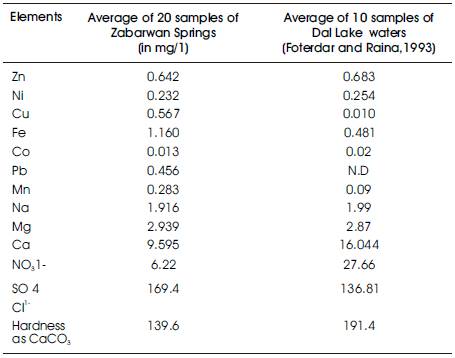
Table 2. Concentration of various elements of Zabarwan Spring compared with those of Dal Lake waters
Manganese:- In the geochemical cycle, Mn goes closely with iron in the rocks and it is the first element to get detached from the silicate rocks (Horowitz, 1974). Further smaller the grain size, more manganese will the sediments contain. Experiments regarding the riverine transport of the sediments by (Gibbs, 1967) and (Horowitz, 1974) have amply shows that at lower levels, Mn gets greatly enhanced. The perusal of Table-l clearly shows the maximum concentration of Mn in the Zeethyar spring as compared to other springs. Next highest concentration of Mn is in the waters of Cheshma Shahi, though the spring is entirely covered by the structure that it is having, but still the Mn ions facilitated to enter into the solution of the spring. The reason for this is that above Cheshma Shahi, the rocks have been fractured due to excessive erosion and deforestation and so ions of various elements get an easy entry into the solution of the waters, Secondly the existing structure over the spring has not been repaired since a long time and hence around the spring, the joints and lineaments have resulted which could be the easy passages for the metal ions brought down by various nallas and small streams alongwith sediments to enter into the spring waters. Similarly, in Zeethyar also the structure raised over the spring has not been repaired for a long time and hence through joints and fractures the run offs from higher levels during rains enter into the water of the spring easily.
The Mn concentration overall has exceeded the permissible limits in the three springs viz., Zeethyar; Cheshma Shahi and Ishber springs of the Zabarwan mountains and as such the waters of these three springs can be considered toxic for the human consumption unless chemically treated.
Calcium:- The highest concentration of Ca has been detected in the samples collected from Zeethyar spring (Average 13.8 ppm). In other springs it is almost uniform. The calcium concentration found in the springs is higher than the other natural water system, but it is consistent with the higher calcium present in the trap rocks (Pareek, 1988). The average concentration of calcium of 20 water samples works out to be 8.46 ppm, which is below the toxic limit (The permissible limit of calcium for drinking water supplies is 200 ppm, (Kudesia, 1989) and hence the water of all the four springs with respect to calcium can be considered as non- toxic.
Magnesium:- The concentration of magnesium in all springs is much below the toxic line. The average of 20 water samples from all the four springs works out to be 2.16 ppm. Magnesium concentration is controlled by pyroxenes and amphiboles of the trap rocks appreciable amount of which are present in the rocks of the watershed area of all the springs. The concentration of magnesium for drinking water supplies is 150 ppm (W.H.O., 1984) and hence the water can be considered non-toxic.
Sodium:- The sodium concentration in all the four springs is present below the permissible levels. The values of calcium, magnesium and sodium are widely used to measure the agricultural potential of the water (Kudesia, 1991). In the present case also these values were calculated. The S.A.R. values less than 26 and S.S.P. values less than 60 indicate that the waters of all the four springs can safely be used for agricultural purposes.
Three anions viz., nitrates, chlorides and sulphates were determined and the perusal of Table-l reveals that all these are present below the permissible limits. The waters are saline because of high chlorides present in the springs. The higher concentration of nitrates present in Zeethyar and Ishber springs is the main concern as these are found slightly more than the averages found elsewhere in the natural water systems. The average of five samples in case of Zeethyar spring works out to be 11.28 ppm and in five samples of Ishber equal to 9.072 ppm. The higher concentration of nitrates, though not alarming at this stage may go to higher levels in the near future.
During, the last decade or so, human settlements around Ishber Zeethyar and Chesham Shahi have been encouraged by the government and the faulty drainage from the sewers may be the main cause of high nitrates in the present case. Secondly the excessive use of fertilizers also has contaminated the waters with nitrates in whole region. Unless the unauthorized settlements are removed around the springs and excessive manuring stopping forthwith, there may be health hazards faced by a large number of people in this region who mostly take the waters of these springs. Moreover, these springs being situated in the water shed areas of Dal Lake, the nitrate level in this beautiful lake also is apt to move higher. The Dal Lake waters reveal 27.65 ppm of nitrates (Fotedar and Raina 1993) apt to disturb the aquatic ecology of Dal Lake, which is already on the way of facing extinction (Khan 1992, Koul 1992, Koul 1993, Koul 1994).
The comparison of various elements detected in the springs with those of Dal Lake waters (Table-2) clearly indicates that most of the contaminants particularly heavy metal elements and anions like nitrates are moving into the Dal Lake waters unabatingly and are causing a general rise in the inorganic and organic effluents in Dal Lake waters.
Hardness values in all the 20 samples waters are lower than the permissible limits. Turbidity values indicate waters of Ishber spring to be dirty, while as in case of other three springs the values are lower. Ph in the samples is within the permissible range.
The present study reveals that most of the water samples of these springs were found polluted in heavy metal contamination profile. Very few samples evidenced the slightly less significant metal concentration. It is attributed to the concentration of various anthropogenic and agricultural activities in the immediate vicinity of these springs.
In order to maintain aquatic ecology of the springs and that of Dal Lake waters, the following measures are suggested: